Eröffnung: 12. Juli 2022 ab 19 Uhr
Finissage: 16. Juli
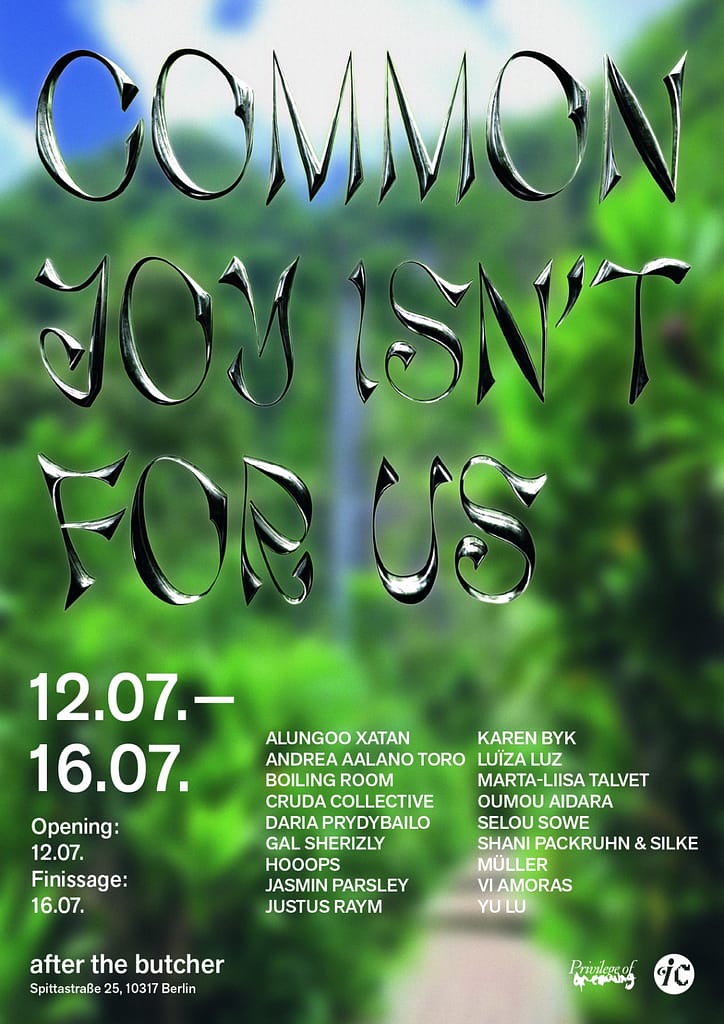

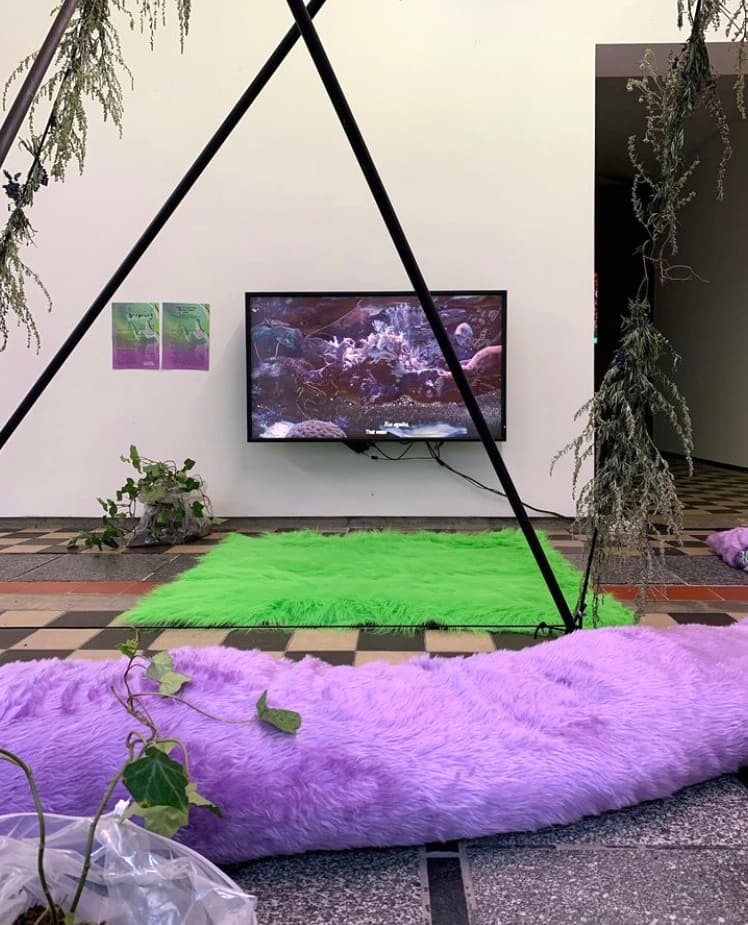
Eröffnung: 12. Juli 2022 ab 19 Uhr
Finissage: 16. Juli



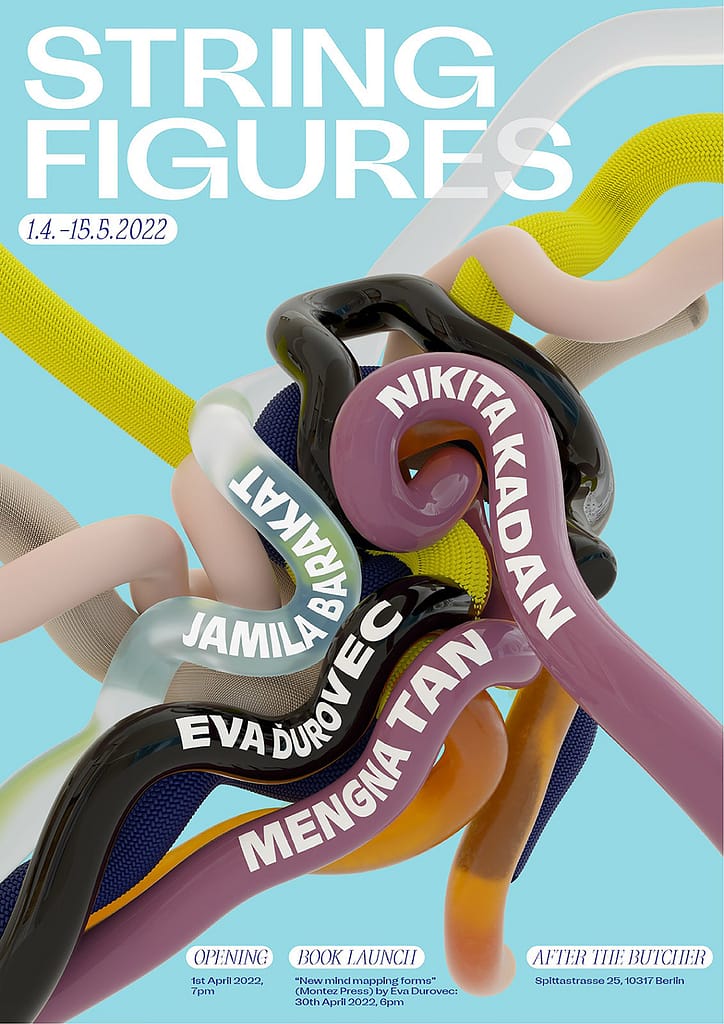
atb#90 – String Figures
Jamila Barakat, Mengna Tan, Eva Ďurovec and Nikita Kadan
Opening Friday, April 1, from 7 pm
Exhibition: April, 2 – May, 15 2022
Finissage: Sunday, May 15, from 3-6pm
Open by appointment: mailto@after-the-butcher.de or +49 178 3298 106
30 April, 6pm: Book Launch „New Mind Mapping Forms“ by Eva Ďurovec
In the exhibition rooms, please keep your distance and wear mouth and nose masks.
After the Butcher, Showroom for Contemporary Art and Social Issues is happy to present its next exhibition “String Figures” with artists Jamila Barakat, Mengna Tan, Eva Ďurovec and Nikita Kadan.
In Donna Haraways “Staying With The Trouble“, one figure is omnipresent: SF. This figuration seems to be more than just an abbreviation. It seems to be a subject that opens up different opportunities and methods, thought experiments and common practices of exchange and interaction. Cross-species practices that sometimes work, sometimes fail, are active and sometimes stay still.
Like string figures, they propose and enact patterns for participants to inhabit, somehow, on a vulnerable and wounded earth. Haraway describes the figure with the letters SF that can be: Science Fiction, speculative fabulation, string figures, speculative feminism, science fact, so far…
“I think of sf and string figures in a triple sense of figuring. First, promiscuously plucking out fibers in clotted and dense events and practices, I try to follow the threads where they lead in order to track them and find their tangles and patterns crucial for staying with the trouble in real and particular places and times.”
D.H.
By playing string figures, new patterns or images are formed that reveal new entanglements and interconnections.
In the exhibition “String figures” the artists are tracing SF by working, failing and exploring themes and contexts of speculative feminism, speculative fabulation, science fiction and so far…
A dialogue with each other begins, connections with each other emerge. While we prepare this exhibition the Russian regime under Putin launched its war against Ukraine. For this reason we decided to pick up another thread: we invited the Ukrainian artist Nikita Kadan (he has to protect himself in Kiev against Russian bombing) to join the exhibition. We are happy to be able to show two of his wonderful charcoal drawings from the series „Minsk Masks“ in String Figures*). In this respect, SF may also be read as a sign against war: stay friends or seid friedlich (be peaceful) instead of Strike Forces.
*) Nikita Kadan writes: “I found these ‘masks’ in ornaments on the ceiling of the Minska station of the Kyiv Metro since I was six years old. They were really scary, and I felt that I could always find new ones. The ornamental composition “Tree of Life”, based on Belarusian folk ornaments, was created by the artists Stepan and Vasyl Khymochka in 1982, the year I was born. Much later I found out that Belarus was historically associated with a partisan movement – these associations can give new meaning to the camouflaged faces hidden among the floral motifs.” These drawings are very topical in that metro stations such as Minska station in Kiev at the moment serve as shelters from Russian shelling and bombardment….
http://www.mirmetro.net/kyiv/cruise/02/11_minska

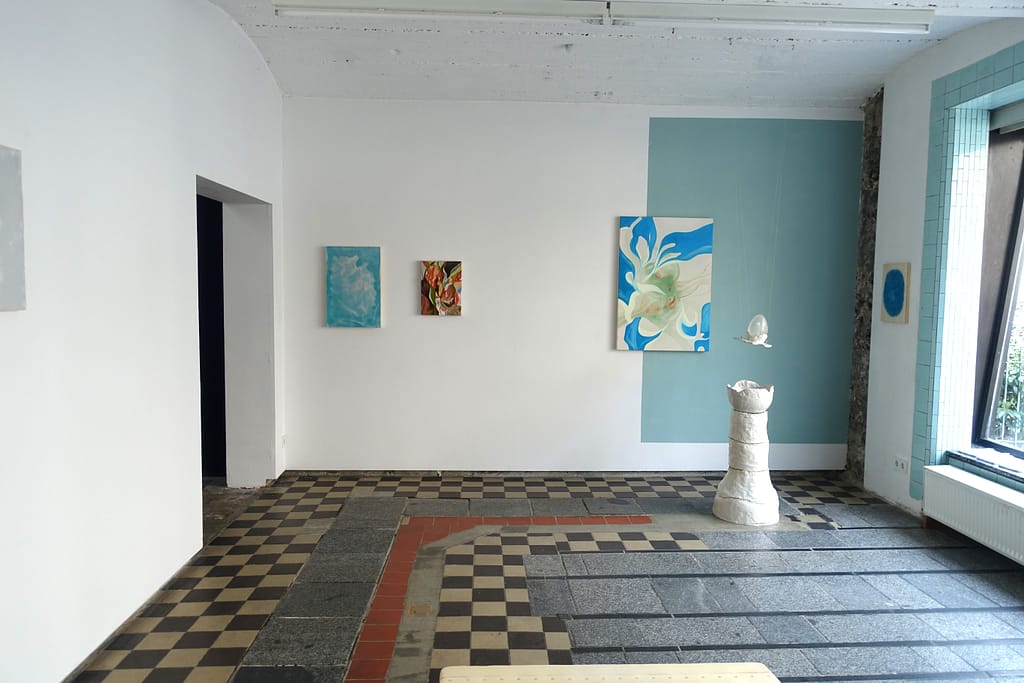
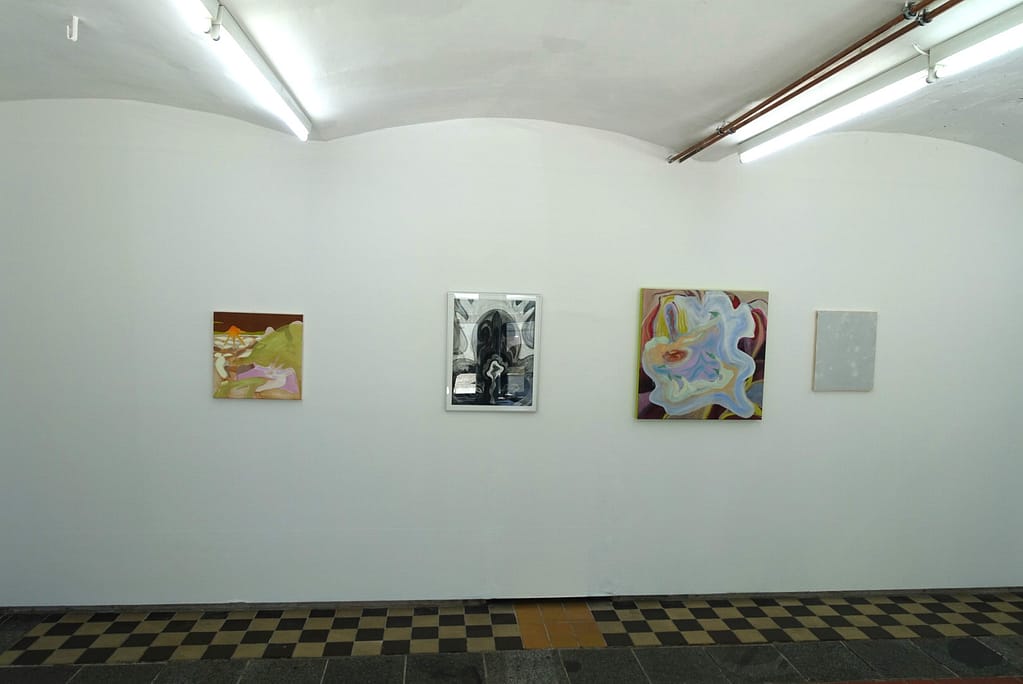
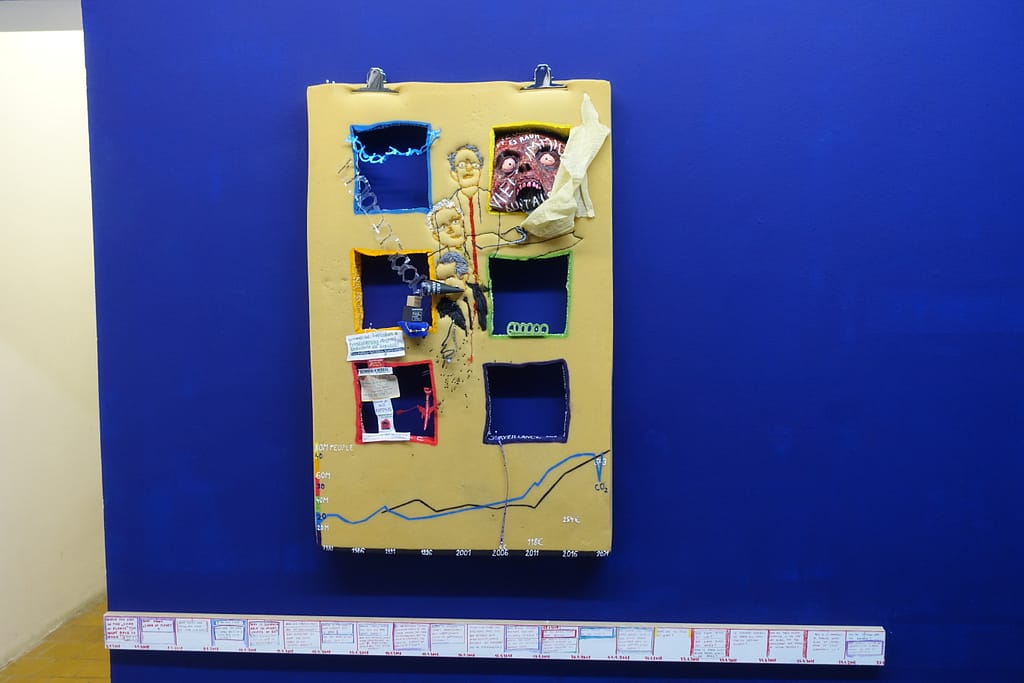
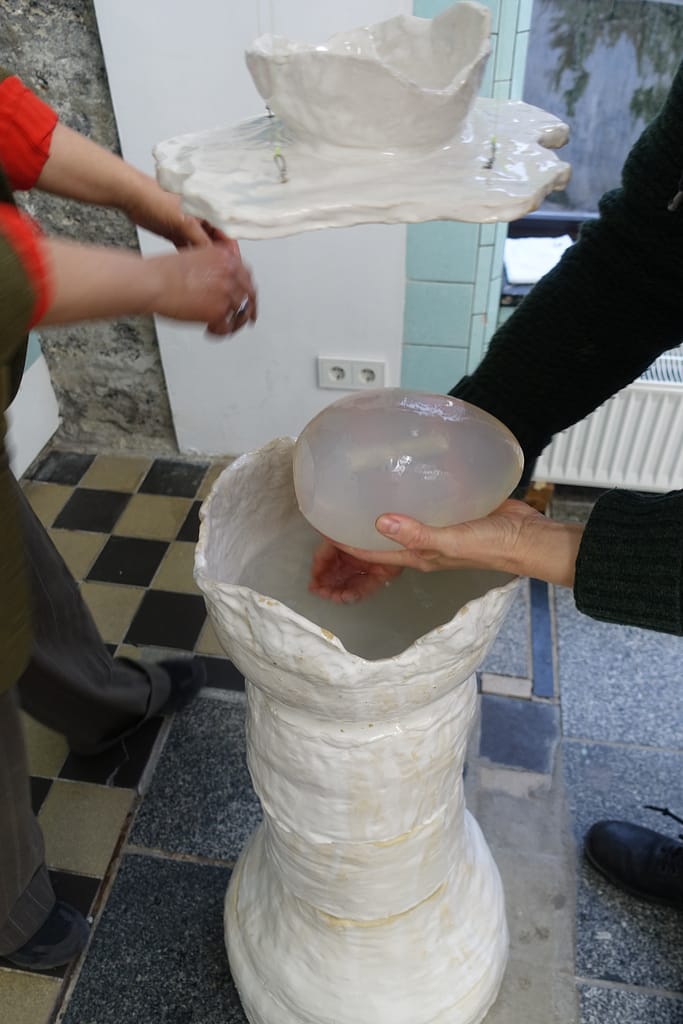

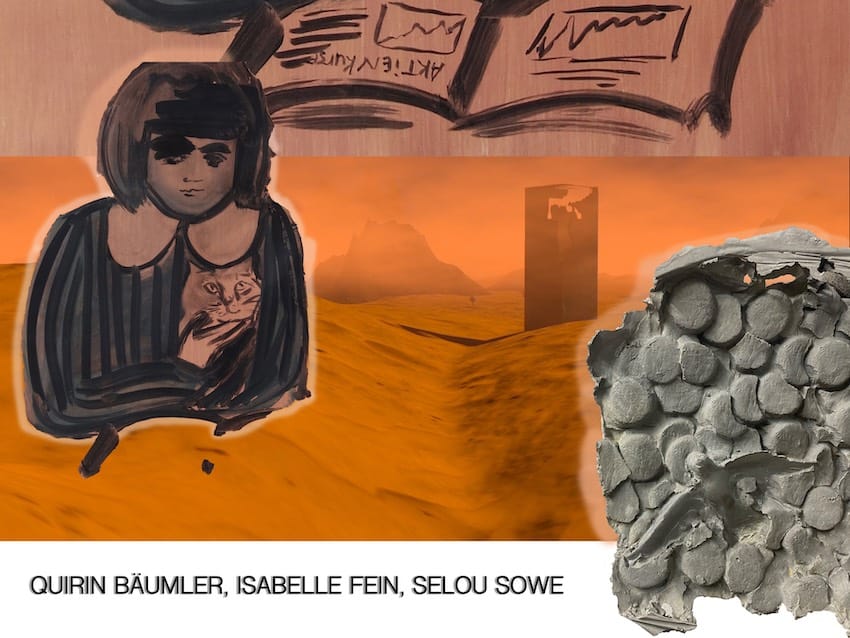
atb#89 | Quirin Bäumler, Isabelle Fein und Selou Sowe
Opening: Friday, February 18, from 7pm
Exhibition: February 19 – March 27, 2022
Open by appointment: after the butcher or +49 (0)1783 298 106. Please wear a medical mouth and nose protection.
About the Exhibition:
Quirin Bäumler, Isabelle Fein and Selou Sowe
18 February to 27 March 2022 at after the butcher, Berlin
Everything is connected with each other. Some time ago we might have rolled our eyes in exasperation at this sentence, inhaling and exhaling in a contorted yoga pose. In the past two years, however, this wisdom has been made bitterly clear to us. How do humans, nature and technology influence each other, and what are the consequences for the macro and microcosms of the world? In this group exhibition, we look at that triangle from various axes of vision, zooming in on small, fleeting relationships and using a wide angle to grasp the power of globalization. The question of how the individual subject influences these connections is made material in the three artistic positions presented, as an interplay of control and chance.
Let’s start with the microcosm: Isabelle Fein’s paintings and sculptures examine brief moments and constellations that either come to her by chance from the outside, for instance found photographs, or that she draws from within herself. Sometimes symbolist in nature, sometimes surreally humorous, her figures and animals emerge from the thin layers of pastel hues before us, communicating with us. Still lifes with brush, newspaper and cups of paint trace her work as an artist: it is a solitary but also meditative activity in which digressions from everyday life are intentional.
Fein’s compositions carry something secure in them, which we can also discover in Quirin Bäumler’s sculptures. His three reliefs on view are made of hard plaster, showing lonely dreamy figures, animals or even a firmament of stars. Like screen monitors, they reproduce an excerpt—a still image from life—which Bäumler has alienated and fixed. While here the material has been cast, shaped and removed through a long, laborious process, his drawings are created intuitively, a psychogram of the moment. Predominated by motifs of death and mourning, we see the traces of two tragic pandemic years.
Away from man, now, and towards the machine. Selou Sowe’s sculptures shimmer in a place between technical progress and industrial decay. They are objects that can hardly be classified: are we dealing with something organic or inorganic here? Is this thing still of this world or has it fallen from outer space? With a view to global connections and informatic achievements, Sowe’s video work shows the similarities between man-made systems and natural structures which have become clearer with advances in worldwide networking. In found-footage images overlaid with his own 3-D animations, an artificial voice-over raises the question of whether the demise of destructive power structures in a supposedly decentralized world would mean our salvation.
This group exhibition is the first part of a long-term cooperation between After the Butcher and the young artists’ group Interspace Collective.
Interspace Collective includes: Isra Abdou, Jamila Barakat, Frank Jimin Hopp, Heiko Thandeka Ncube, Selou Sowe, Mengna Tan, Laura Suryani Thedja and Alungoo Xatan.
Text: Nadja Abt
Translation German/English: Michael Baers
after the butcher explicitly is in support of the open letter
Who Owns the Public? on the so-called “Kunsthalle Berlin”/Tempelhof
that you can sign here: https://docs.google.com/forms/d/e/1FAIpQLScODqiG38AtCQt3BhOJim7qVGzDNJyYmrXAvbGFktu5W7uCSA/viewform
Ciara Phillips | Jean-Ulrick Désert

Palimpsest – Reading between the signs
Ciara Phillips | Jean-Ulrick Désert
Exhibition: November 27, 2021 – January 30, 2022
Opening: Friday November 26, 2021, 7-11 p.m.
Finissage: Sunday, January 30, 2022 from 3-6 p.m.
Viewing by appointment only: ina@after-the-butcher.de or mobile: +49(0)178-3298106
Social distancing measures must be observed in the gallery spaces and wearing a medical mask is compulsory.
The exhibition Palimpsest / Reading Between the Signs develops a visual dialogue between the works of Berlin-based Haitian-American artist Jean-Ulrick Désert and Glasgow-based Irish-Canadian artist Ciara Phillips.
Jean-Ulrick Désert takes up in his work, developed for this exhibition, a political action at the Berlin Wall from 1978 by the filmmaker Wieland Speck (1992-2017 Director of the Panorama of the Berlin Film Festival) and the artist Per Lüke, which immediately triggered a surveillance investigation file called “The Harpist” (Der Harfenspieler) by the GDR’s State Security Police. For his installation Désert selected 12 sheets from the Stasi files, digitized them and burned them in linen to create ‘modern ruins’. The data from this Stasi surveillance and Désert’s research generated four astrological circular terracotta forms. They mark the star constellations and the astrological configurations taken from the 13 August 1978, 16:15, the day of the political action. Another disk marks the life span of the surveillance and yet another disk marks the collaborative dynamics of Per Lüke & Wieland Speck. Together with the picture panels they create a poetic palimpsest and a tension between personal and public, analogue and digital or physical and metaphysical realities.
For this exhibition, Ciara Phillips foregrounds clothing as a site of social engagement and meaning. Sewing has long been an artistic practice for Phillips, realized in parallel with her graphic print work. Printed textiles are often part of her complex spatial installations. Phillips explores the myriad ways in which print intersects with our daily lives, whether through media, advertising, banknotes, or clothing. Everywhere, print products act as important validators and signifiers. Phillips spent 4 weeks in residency at Lichtenberg Studios developing new works for this exhibition which draws on, among other things, the centuries- old history of textile and clothing manufacturing in Lichtenberg.
article about the exhibition at artlink


Ciara Phillips works mainly in print and her approach is both expansive and experimental. She often works collaboratively, transforming galleries into working printshops and inviting other artists, designers and local community groups to work with her. She has exhibited at: Tate Britain; Museum of Contemporary Art Australia; Benaki Museum, Athens; Hamburg Kunstverein; and Kunsthall Stavanger. In 2014 she was nominated for the Turner Prize, and in 2020 was awarded the Queen Sonja Print Award in Oslo.
Jean-Ulrick Désert works in different media: posters, actions, paintings, site-specific sculptures and video. In 2019 Jean-Ulrick Désert represented his native country Haiti at the 58th Venice Biennale in the same year he showed Unfinished Histories Vol.IV, at the Franziskanerkirche Monastery Ruins, Berlin. In 2013, Amour Colère Folie, Art Commission, Martinique Biennale, Martinique; 2015 Belgian Soliloquy, Platform 102, Brussels; Jean-Ulrick Désert, Espace d’art Contemporain 14°N 61°W, Martinique; 2018 Jean-Ulrick Désert, S12 Studio, Select World Project Gallery, New York. He was a participant in the 10th Havana Biennial, Cuba, in 2009. Désert founded his Berlin studio in 2002. www.jeanulrickdesert.com
Jean-Ulrick Désert is the first recipient of the Wi Di Mimba Wi :: AKB & SAVVY Contemporary Award: www.e-flux.com
Bernadette Van-Huy | Herman Asselberghs
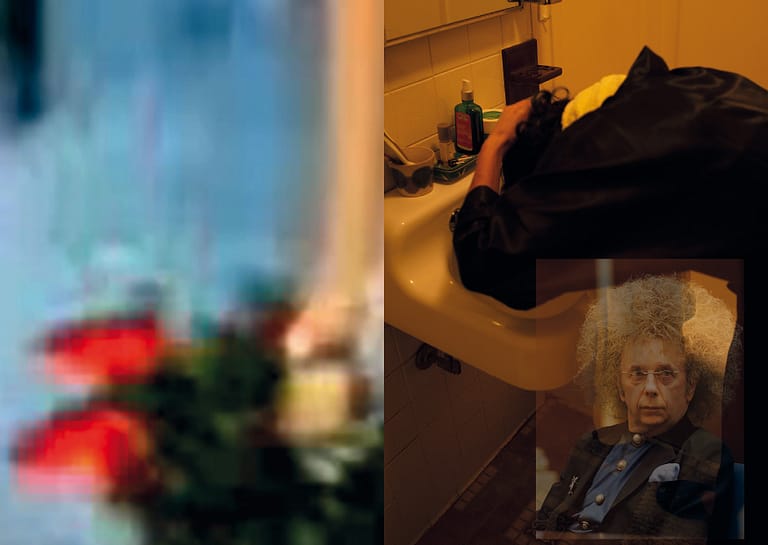
The Few, The Many
Exhibition: 16. October – 14. November 2021
Opening: Friday 15. October 2021, from 7 p.m. on
Finissage: Sunday November 14, from 3-7 p.m.
With its upcoming exhibition The Few, The Many, after the butcher is delighted to present two contemporary artistic perspectives from New York and Brussels. For the exhibition at after the butcher, New York-based artist Bernadette Van-Huy produced a new twelve-part photographic drawing series titled Turn the Mirror Upside Down. The self-portraits, accompanied by a wall text in the form of a mirror-written instruction for action, are about an outlaw, a book, outer space, an Asian, and a homemade perm.
At the invitation of after the butcher Belgian film artist Herman Asselberghs made Now (After Empire Remix) (video, color, 16:9, English, BE, 2021, 18’), a remix version of his video After Empire from 2010. In After Empire, Herman Asselberghs suggested an alternative for the iconic image that collective memory has kept as the quintessential moment of recent history: the worldwide anti-war demonstration on the 15th of February 2003 instead of two towers collapsing on the island of Manhattan. Today, a decade, a commemoration of 9/11 and many marches all over the globe later, the filmmaker presents a remix version by providing part of the initial images with a new, contemporary soundtrack by Simon Halsberghe and Wiet Lengeler.
At the occasion of the exhibition, butchers blätter #3 will be published next to the online format as well as a print edition, with contributions by Dieter Lesage, Andreas Siekmann and Ina Wudtke.
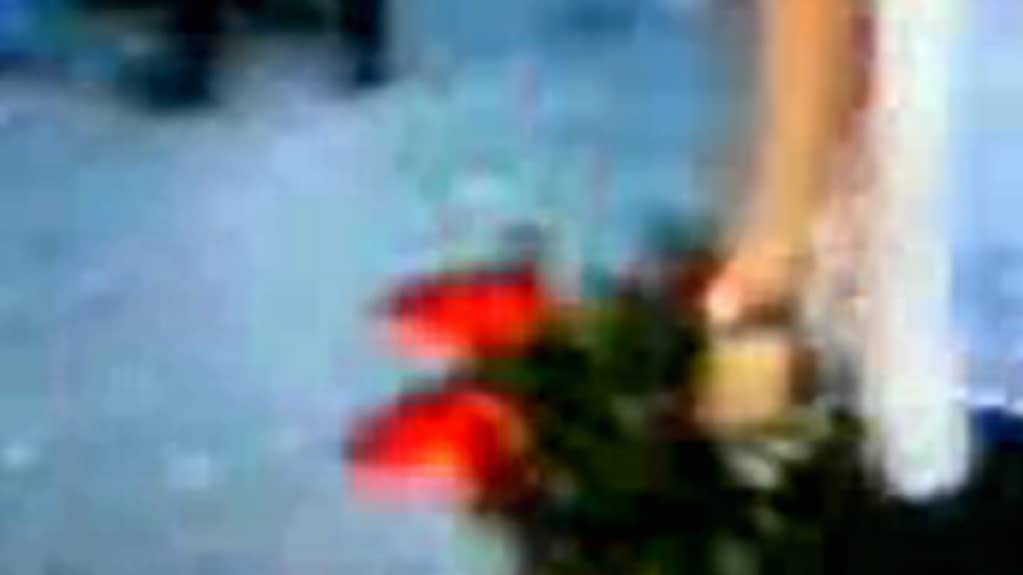

Bernadette Van-Huy is a founding member of Bernadette Corporation. She has also been working artistically under her own name for several years and exhibits internationally. She lives and works north of New York, USA.
Film artist Herman Asselberghs (°1962) explores border zones between text, sound and image, world and media, poetics and politics. Over the past two decades, his film and installation works have been shown internationally. He teaches at the film department of LUCA School of Arts – Sint-Lukas Brussel and is a founding member of the Brussels production platform Auguste Orts (augusteorts.be). He lives and works in Brussels, Belgium.
With the kind support of:

Kaj Osteroth & Lydia Hamann | Xiaopeng Zhou

Good Copy – Bad Copy
Exhibition: August 22, 2021 – October 3, 2021
after the butcher is delighted to present the forthcoming exhibition representing two artistic perspectives whose work not only addresses fundamental social questions but also explores copying through drawing and painting as an artistic method.
Lydia Hamann & Kaj Osteroth have worked together as an artist duo since 2007. They are currently working on their project Glamshots. Malerinnen in der Berliner Gemäldegalerie (Glamshots. Women painters in the Gemäldegalerie, Berlin), with the relationship between the art works of female and male artists from the permanent collection of the Gemäldegalerie, Berlin. It is striking that out of 1000 paintings on display, only 6 are by women artists: Anna Therbusch, Marie Vigee-Lebrun, Angelika Kauffmann, Marie Latour, Anne Vallayer-Coster, Sofonisba Anguissola. The picture is no less problematic in the entire gallery holdings, where only 20 of the 3500 pictures are by women artists. Lydia Hamann & Kaj Osteroth decipher the pictures by these women artists through a collaborative analysis of moments, gestures and viewpoints. The results are a sampling of details from 20 different pictures from the collection on display and in storage. Hamann & Osteroth are big fans of repetition and imitation, copying the paintings of other women artists. They imitate, recreate, interpret, fail, are confronted with their own possibilities and methods, understand, admire and surrender to the ecstasy of colour. In this way they move within a fascinating dialogue, in front of and with the originals. In conversion to canvas, they trust in their usual methods of incapacity, a cheerful copying, accompanied by inability and reluctance and the question of what makes a good copy or a bad copy.
The Chinese artist Xiaopeng Zhou has taught drawing to an elderly lady in Berlin for some time. In the beginning he taught her to draw flowers, trees, cacti and other plants in the Botanical Garden and in turn, drew her while she drew the plants. In doing so, he used reportage drawing as an important method of his artistic research. During the lockdowns, Zhou and the elderly lady met in her apartment to continue drawing and he learnt more about her interest in philosophy, literature, art history and feminism. The learning process became reciprocal and more intensive as Zhou improved his German language skills as well. At after the butcher, Zhou presents a video work documenting this joint learning and working process. He also shows some of the drawings that were made in this context, drawings from the Botanical Garden and her apartment in which conversations happened about emotional and physical work, illness, therapy and healing and their own different experiences of age, gender and culture.
The duo Lydia Hamann & Kaj Osteroth question stereotypical attributions, dominant Eurocentric fictions and their own experiences of the scope of collective practice. Kaj Osteroth studied Art History and Ethnology at the Freie Universität and Fine Art at the University of the Arts, Berlin. Lydia Hamann studied Art History and Cultural Studies at the Humboldt University and Fine Art at the Kunsthochschule Weissensee, Berlin. In 2020 they were awarded the Villa Romana Prize. They took part in the exhibition Histórias Feministas / Feminist Histories at MASP, São Paulo in 2019. In 2018 they published the book Racical Admiration and were part of the We don’t need another hero Berlin Biennale. In 2017 they took part in The Future is Female festival with a workshop at the Sophiensaele, Berlin. www.fleeingthearch.org
Xiaopeng Zhou studied at the Kunsthochschule Weissensee Berlin and at the Guangzhou Academy of Fine Arts. His most recent solo exhibitions are: Monochromatic Lottery Balls, Xining Contemporary, Xining, 2019 and Shape of Appetite, 2018, Empfangshalle München (in collaboration with Han Tang). Group exhibitions: BPA-Exhibition, 2021, KW Berlin; Interrupted Meals HOW Art Museum, Shanghai, 2020; An Impulse to Turn Inside-Out Art Museum, Beijing, 2020; Further Thoughts on Earthy Materials Kunsthaus Hamburg, 2019 and Bi-City Biennale of Urbanism\Architecture, (UABB), Shenzhen, 2017. www.xiaopengzhou.com
Funded by:

Shannon Bool, Anton Bo Matzke, Kim Hankyul
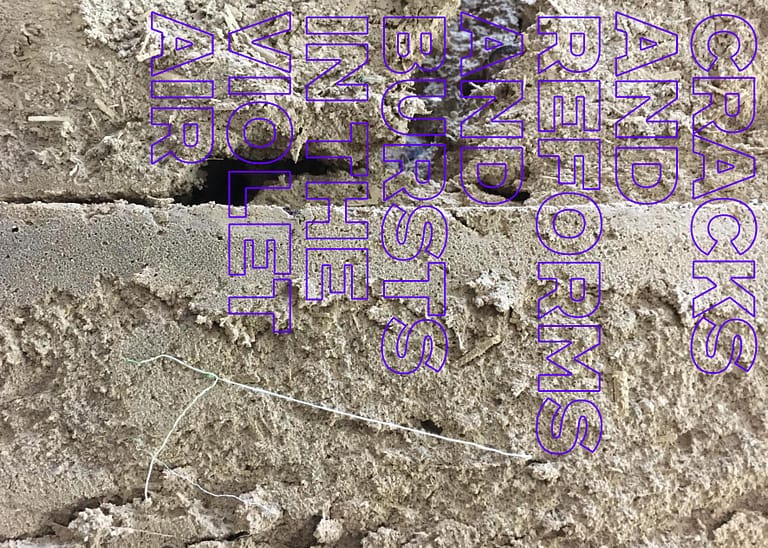
Exhibition: June 18 – August 15, 2021
Cracks and Reforms and Bursts in the Violet Air presents a constellation of artworks by Shannon Bool, Kim Hankyul and Anton Bo Matzke that meditate on the status of artistic production within broader fields of social relations. The title of the exhibition borrows a line from T.S. Eliot’s, The Waste Land (1922), an influential early modern poem that makes use of numerous images and lines of text from other sources to describe a post-war landscape through affects, shifts in voice and fragmented narratives rather than through factual description. The allusion is fitting, considering the current sense of uncertainty in the wake of the pandemic, as well as an overall disillusionment with living for over 30 years under neo-liberalism and its social and economic failures. The artists have used the situation to mount a series of artworks that repurpose and redistribute means of production and interrogating systems for valuing everyday life.
Shannon Bool’s large-format tapestry, Crimes of the Future, appropriates a documentary photograph of an exhibit in the Yves Saint Laurent Museum in Paris. The work proposes a complete rethinking of the materiality of images through perforating and exploding the symbolic language of photography as an artistic medium. The grid of pixels that make up the digital image are technically translated into a Jacquard weaving – resolution gets fuzzy in the process. Mannequins are elided and replaced by collaged images of signature brutalist buildings, echoing the digital, systemic control of information. Alongside a ‘digital’ sensibility in the artwork is as well an ‘analog’ one: the representation of the female body is revealed as a projection screen and cipher of a consumerist gaze. Bool resurfaces the generic silhouettes to present specific, high-modern dwellings of religious culture such as the Wotruba Church in Vienna by Fritz Wotruba, the Neviges Church in Düsseldorf by Gottfried Böhm, or the Second Goetheanum in Dornach by Rudolf Steiner. The modern myth of the sacred value of legibility of purpose, achieved by a balance of design and choice of materials, is upended by Bool, revealing a whole hierarchy of hidden bourgeois values that are ultimately designed to manage desire as well as the movements and labour of human bodies.
Kim Hankyul’s Serpent (2016) and Bird (2019) are two of his earlier kinetic and sonic sculptures that repurpose ordinary tools and materials to serve as substrates for new meaning. The works ‘perform’ absurd yet everyday movements and tasks that are either excessive or underwhelming in the mimetic sense, further taking advantage of the gap between sign and signified. Serpent moves excessively, the effect of the writhing and wild hissing of the ducting is manic and haunting – one is witness to an expenditure that begins from an electrical outlet and ends somewhere in the imagination. Bird features two pages of a book held by an armature that is animated by a drill that you can make out the gentle beat of its wings. The book – two of its pages – are transformed from a cognitive container of knowledge to an object of poetic reflection on the dream of flying. In this respect, the sculpture also tangentially evokes class associations: knowledge is power. This is the very key to their magic: the viewer is left to judge the effect of the work, and yet is repetitively returned to the mechanical slavery of its performance. In my eyes, the kinetic sculptures pose critical questions in terms of working class labour and its relation to contemporary artistic production – is labour unsightly? Is it too sweaty? Does it strive too hard for expression, for meaning? In this sense, the works are humorous and very effective in their easygoingness.
Anton Bo Matzke’s Melde (2021) and Hom(e)age (to stonemason Ekhof Platz) (2018) are sculptures that symbolically and materially draw their qualities from the environment of the exhibition space; they seem to precipitate the site in which they are presented. They are quiet objects that express the transitoriness of life in a manner akin to still-life painting. Melde is a clay sculpture whose form evokes that of contemporary architecture. The artist has planted ruderal seeds in the raw clay which he collected from a vacant lot in the Victoriastadt, nearby after the butcher. Over the course of the exhibition, the sculpture will be animated by the growth of vegetation, – it will take on a life of its own, so to speak; the seeds and their roots will slowly crack open its form and possibly cause the form to collapse: work in progress. Hom(e)age (to stonemason Ekhof Platz), is a sculpture in the form of a standing floor lamp, whose base of poured concrete and metre-long piece of rebar also present construction materials often discarded in vacant building lots. The unusual element is a marble lamp shade atop the rebar that is old and crinkled- looking as though one would smell cigarette smoke on it. The overall sensibility of the works is one of improvisation with materials at hand, and what they address are issues concerning gentrification, class and urban renewal – for better or worse.
Text by Maxwell Stephens
We look forward to your visit.
funded by:

CLASS OF ASTA GRÖTING

RANDOM ACCESS MEMORIES
Andreas Baumgartner, Laura Dechenaud, Jan-Louis Gens, Leonardo Grüning, Pauline Hömmen, Juhi Hong, Gregor Kieseritzky, Charlotte Kremberg, Luis Kürschner, Johannes Möller, Jeroen Laessig, Sophie Pape, Lucila Pacheco Dehne, Camilla Schiegnitz, Stefan Schramm, Julika Teubert, Simiao Yu, Yuan Yuan, Hye Yun
Exhibition: May 7-June 13, 2021
after the butcher, showroom for contemporary art and social issues is pleased to invite you to visit random access memories an exhibition with students from the class of Asta Gröting at the Braunschweig University of Fine Arts.
Exhibition: 7 May – 13 June 2021
Opening hours: Fridays 5pm-10pm, Saturdays 12pm-8pm and Sundays 12pm-6pm. We kindly ask you to register for the visit by mail:
ina@after-the-butcher.de or call us on 0178-3298106 to get your personal time-slot.
Current rules to prevent the spread of C19 apply in the showrooms.
When we dream, we are in a place that seems to exist alongside our reality. A previously hidden conglomeration of unconscious impressions, fears and desires opens up to us. For the surrealists, the reality experienced during sleep was no less important than the waking state. André Breton wrote in his Surrealist Manifesto of 1920:
“(…) why should I not concede to the dream what I sometimes deny to reality, namely that value of my own certainty which is not at all denied by me during the dream-span?”.
At least this effect directly experienced in the dream can hardly be evaded by anyone. Despite this, or precisely because of it, we often find it difficult to draw and comprehend the line between dream and reality. This is particularly noticeable in utopias and daydreams, which often speak of desires and ideals that do not seem attainable for us at all.
In the exhibition random access memories, the Gröting class asks how reality can influence our dreams, or rather how dreams influence our reality.
“We have actually met every week on Mondays since January to establish a common process. Continuity was especially important because we couldn’t meet in real life. We always try to shape and decide everything democratically and on a horizontal hierarchical level. This slows down the process, but it is important for our class cohesion.
We do this by looking at what topics interest and excite us at the moment and connect us all in some way. We decided on the topic of dreams because we see it as a nice option to connect the personal and the social.
To develop the concept together, we started doing dream experiments. We set ourselves a new task every week to see if we can influence our dreams together. For example, one week we all listened to the same song before going to bed to see what would happen. Another week we read an excerpt from André Breton’s Manifesto of Surrealism, which is also about dreams, as the last action before going to sleep. We wrote down our daily routine and actively tried to control our daydreams. Through these experiments we got into conversation with each other about what dreaming means and how we dream.
What was strange about the process was that it is actually a very personal and individual topic, but the online conference naturally brought a certain distance into it. Sitting together and hatching together in our studio was sorely lacking! But I still think that the exhibition was just the right thing at this time to work on something together again and to plan something more concrete and to get into conversation. I think it was and still is very good and important for the class and its development process that there is this common “point” of the exhibition, the bringing together of the works. Maybe it will be the key when we look back later on this special, also difficult period of the pandemic, that we can still remember something beautiful that we worked on and experienced together…” from the communication between students and Asta Gröting.
We look forward to your visit.
funded by:

Vermeir & Heiremans, Julia Cremers & PARALLAX Lab
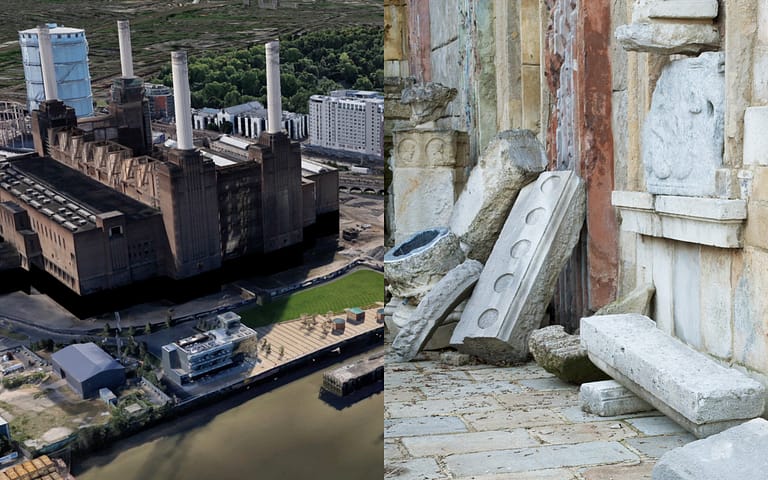
Learning to dwell otherwise within the ruins
Vermeir & Heiremans, Julia Cremers & PARALLAX Lab
Exhibition: March 19 – April 25, 2021
In its upcoming exhibition, after the butcher is pleased to present two artist positions whose work deals with buildings, ruins and questions of their value creation. At the same time, both positions approach the broad field of speculation and reclaim agency – new modes of action – against it.
The artist duo Vermeir & Heiremans will show the short film A Modest Proposal (in a Black Box). The film explores whether “financialization” can be repurposed as a tool for creating more just conditions. The artists propose a model to financialize public art collections, museum properties and/or their symbolic capital. This model aims to create a cycle of wealth that benefits not only investors and institutions, but also the creators of these assets, the original stakeholders – the artists and art workers.
As a case study in the film, Vermeir & Heiremans discuss the financialization of the Pump House Gallery in Battersea Park, London with their lawyer. The gallery is located near Battersea Power Station, a former coal-fired power station from the mid-20th century, which after 40 years of vacancy is currently being converted into a luxury shopping center including luxury flats with the participation of “starchitects” such as Frank Gehry and Foster & Partners. The rising property values in its neighborhood will “pump up” the asset value of the gallery building. Introducing this into the artists’ global financial model will distribute surplus values for the wider art community.
Which part of this is ironic critique and which is longing for participation? In any case, the artists expose the social tensions and contradictions generated by speculation and profit maximization alongside the fundamental need for housing.
Julia Cremers and PARALLAX show their collective video and 3D works Ruin Figments and Reconstructed Memories. Both works are centred around an architectural site built in Vienna’s Schoenbrunn Palace Park in the year 1778, depicting the remains after the Roman siege of Carthage in 146 BC. This fake ruin, in line with landscaping fashions of the 18th century, was meant to manifest the power of the Habsburg Monarchy, claiming their imperial pursuits by identifying with the victorious Roman Empire: a speculation on cultural capital.
PARALLAX’ work is a further reimagining of this folly within the present. The ruin’s virtual counterpart is extracted through photogrammetric methods, then distorted and rematerialized. The resulting 3D printed sculpture calls attention to the implicit alterations at each reproduction stage, hereby questioning the cultural impact of imperial collapse and its appropriation by new power structures. The video essay is another uncovering of this layered entity, exposing the material resources and human efforts that are required for the construction of (virtual) spaces.
A third visual element are the photographs Ruins by Julia Cremers, which show military fortifications from the period of Nazi fascism and the German occupation in Bergen/Norway. Today, they serve as a backdrop for raves. The repurposing of these historically burdened sites for festive events can be seen as both problematic and liberating at the same time. It represents a form of reappropriation of charged places, overlaid with new narratives and cultural meaning, thus continuing to write history.
A Modest Proposal (in a Black Box) will be accompanied by a publication which brings together a series of essays that were presented in a symposium, organized by Vermeir & Heiremans at the Royal College of Art, London in 2018.
Film credits:
HD Video, 28′ 7″, sound & colour, UK-Belgium, 2018
with Luke Mason, Heike Langsdorf, Vermeir & Heiremans
Camera: Amir Borenstein
Sound: Justin Bennett
Production: Jubilee vzw, with the support of: The Flemish Community; Art et Recherche asbl; Federation Wallonie-Bruxelles; Pump House Gallery; Wandsworth Council; Enable Leisure and Culture; Art Council England; Cockayne-Grants for the Arts; The London Community Foundation
Ruin Figments and Reconstructed Memories
Video essay and 3D printed sculpture
Film credits:
HD Video, sound & colour, Germany-Austria, 2021
Camera: Lena Kocutar, Daniel Viladrich Herrmannsdoerfer, Julia Cremers
Sound and Editing: Julia Cremers
Research: Lena Kocutar, Daniel Viladrich Herrmannsdoerfer, Polina Nikoulitcheva, Julia Cremers
Ruins
Three digital prints, photography
by Julia Cremers
Vermeir & Heiremans presented work at: 10th and 13th Istanbul Biennial (2007 & 2013), Arnolfini, Bristol (2009), Nam June Paik Art Center, Yongin (2010), Viennale, Vienna (2011), 7th Shenzhen Sculpture Biennial (2012), Manifesta 9, Limburg (2012), Argos, Brussels (2012), Extra City, Antwerp (2012), Riga Art Space (2013), Rotwand Gallery, Zurich (2014), Triennale Brugge (2015), Dojima River Biennale, Osaka (2015), Georg Kargl Gallery, Vienna (2015), Transmediale, Berlin (2016), Bucharest Biennale 7 (2016), Glassyard Gallery, Budapest (2018), The Atlantic Project, Plymouth (2018), Pump House Gallery, London (2018), Carico Massimo, Livorno (2019), Kunsten Museum of Modern Art, Aalborg (2020).
Julia Cremers graduated with a Bachelor of Audiovisual Art at the Gerrit Rietveld Academy Amsterdam in 2016, and a Master of Fine Art at the University of Bergen Faculty of Fine Art in 2018. Julia presented work at: Dutch Design Week Eindhoven (2014), Van Nelle Fabriek Rotterdam (2015), Gallery Bart Amsterdam (2016), Eye Film Museum (2016), Bergen Kunsthall (2018), Deichtorhallen Hamburg (2019), Errant Sound (2020), Alte Feuerwache Köln (2020), Berlin School Of Sound (2021). Cremers has been a member of Errant Sound since September 2020.
PARALLAX Lab, Ruin Figments and Reconstructed Memories is a collaborative project initiated by artist Julia Cremers with students Daniel Viladrich Herrmannsdoerfer (Technomathematics, TU), Polina Nikoulitcheva (Architecture, TU) and Lena Kocutar (Lensbased Class, UdK). Produced as part of PARALLAX Lab, an initiative of the Berlin University of the Arts and the Technical University Berlin. With the support of FormLabs Berlin.
funded by:

November 20, 2020 – March 7, 2021
artists: A-Clip, Gruppe Gummi K / MicroStudio Surplus (Alice Creischer, Martin Ebner, Christoph Keller, Ariane Müller, Andreas Siekmann, Nicolas Siepen, Josef Strau, Klaus Weber, Amelie von Wulffen), Jaaaa & Protzband Nicolas Siepen, Siegfried Koepf & Martin Ebner & Gunter Reski, Josef Kramhöller, NEID, Annette Wehrmann, Ina Wudtke, Amelie von Wulffen and others.
On Thursday February 18, 7 p.m. KW Institute for Contemporary Art, Berlin and after the butcher invite you to an Onlinetalk about the exhibition. Speakers are: Annette Maechtel, Thomas Kilpper, Ina Wudtke and Kathrin Bentele.
Exhibition: November 20, 2020 – March 7, 2021. Due to the current lockdown and until further notice, the exhibition can only be visited online: videowalk through the exhibition.
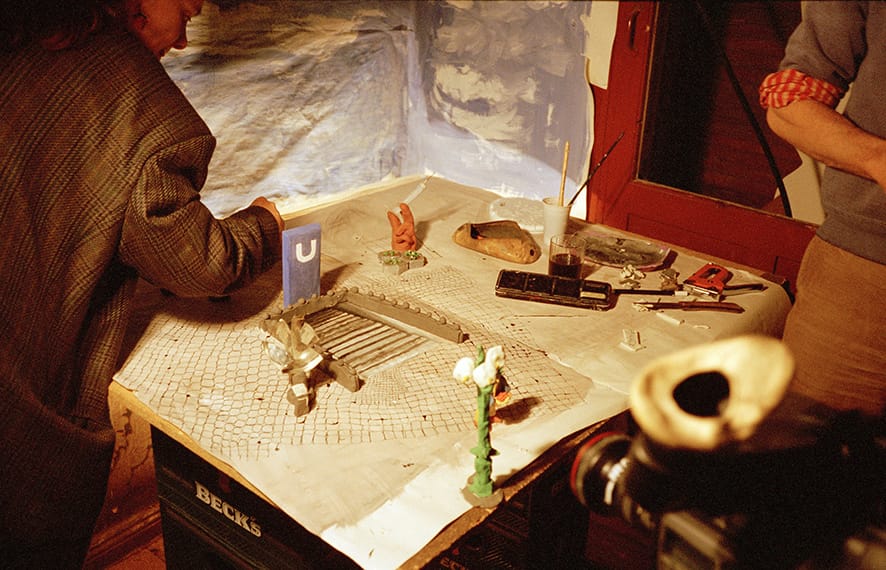
after the butcher presents the group exhibition Stadt und Knete. Positionen der 1990er Jahre, running in parallel with the solo exhibition by Amelie von Wulffen at KW Institute for Contemporary Art, Berlin. A collaboration between KW and after the butcher, the show revolves around four collaboratively produced animation films: Infobox (1996), Wie eins zum anderen kam (1996), and Die Krumme Pranke and Egoland (both 1997). The work Infobox by the Berlin artists’ group Jaaaa & Protzband Nicolas Siepen, Siegfried Koepf & Martin Ebner & Gunter Reski, MicroStudio Surplus reads as a commentary of its time on the structural development of Potsdamer Platz in Berlin. The work also refers to the so-called “Infobox” pavillion, which was installed from 1995 to 2001 at Leipziger Platz.
In 1996, the group Gummi K / MicroStudio Surplus produced the video work Wie eins zum anderen kam, which vitriolicly and ironically criticizes the major exhibition Nach Weimar at the Neues Museum Weimar, organized by Klaus Biesenbach and Nicolaus Schafhausen. The work addresses the structural relationships between the Neues Museum and the Gauforum, with the latter being built in the National Socialist era, as well as the resulting legitimization of fascist architecture as an exhibition space for contemporary art.
Die krumme Pranke, a video work by Alice Creischer, Andreas Siekmann, Josef Strau and Amelie von Wulffen performs in the lineage of the classic Derrick crime-series. Situated in Berlin, the visual vocabulary of this metropolitan thriller moves between documentary shots and fictional animation. Domestic politics and the development areas of the 1990s act as central motifs of this filmic montage, in which the artists shift from art practice to political activism and reverse.
Egoland from 1997, is a 55-second cinema spot from the A-Clip series. Collectively produced, the political messages of the A-Clips were first inserted by various cinema projectionists in Berlin in the commercial breaks before the main film.
Taking place in 1997 and 1998 in different cities in Germany and in Switzerland the “Innenstadtaktionen” were activities organized with significant participation by political activists from the art context. Katja Eydel, who was also participating, documented some of the Berlin actions at the time. For the exhibition, Ina Wudtke has put together the video Innenstadtaktionen (2020), consisting of Eydel’s photographs and new fragments of interviews with artists formerly involved in the activities. Kollektive Erinnerungen (collective memories) thus gives insight into the political context of the time in Berlin and is a significant testimony of the art production connected to it.
Hamburg based artist Annette Wehrmann (1961–2010) worked on a long-term project that explored urban space, titled Ort des Gegen. It followed the idea that the quality of a city depends on the number of undeveloped, freely available areas. She concluded that, under neoliberal conditions, the “Ort des Gegen” is able “to take the form of a thorough refusal of exploitation”. It becomes the “flipside” of utopia, “a place, where waste sediments and is not being disposed” (from Annette Wehrmann’s text Ort des Gegen, 2002). The exhibition includes five gouaches from the series as well as the foam sculpture Nein.
As one of the first to publish Annette Wehrmann’s Luftschlangentexte, the artist magazine NEID (1992–2004) also documented fragments of the “Innenstadtaktionen” in Berlin. The exhibition features issues of NEID #4 and NEID #7.
Further, Stadt und Knete presents a series of photographs depicting fingerprints on window fronts of luxury boutiques from 1995 by Josef Kramhöller (1968–2000).
Alongside Amelie von Wulffen’s collaboratively produced video works, the exhibition presents three photo collages depicting buildings in East Berlin reflecting her enthusiasm for the Soviet modernism and the remaining parts of a shop window installation from 1996. The plywood figures depict both found and invented logos of manual craft’s companies.
About the artists:
A-Clip, are political short films collectively produced by artists and activists for the cinema, in 1997 and 2000.
Jaaaa (Josef Strau, Amelie von Wulfen, Ariane Müller, Alice Creischer, Andreas Siekmann) was founded in 1996 in Berlin to collaboratively produce animation videos.
Gruppe Gummi K (Alice Creischer, Martin Ebner, Christoph Keller, Ariane Müller, Andreas Siekmann, Nicolas Siepen, Josef Strau, Klaus Weber, Amelie von Wulffen) emerged from the group Jaaaa in 1997 and continued working on video animations.
Josef Kramhöller (1968–2000) was an artist and author. He studied painting at the Akademie der Bildenden Künste in Munich and at the Chelsea College of Art and Design in London. His practice spanned performance, photography, painting, drawing, and text.
MicroStudio Surplus was the name for a temporary studio in Burgstrasse, Berlin. It does not denote a fixed constellation of participants.
NEID was a queer-feminist magazine founded in 1992 by Hans-Christian Dany, Claudia Reinhardt, Heiko Wichmann, and Ina Wudtke at the Hamburg Academy of Fine Arts. It was published by Ina Wudtke from 1995–2004.
Annette Wehrmann (1962–2010) was an artist and author. She studied Fine Arts at the Academy of Fine Arts in Hamburg and at Städelschule in Frankfurt. Her work revolved around topics of urban space and forms of self-organisation.
Ina Wudtke, born 1968, is a conceptual artist living and working in Berlin. Her artist’s book The Fine Art of Living, which addresses issues of gentrification, was published in 2018 by Archive Books, Berlin.
Amelie von Wulffen, born 1966, lives and works in Berlin, studied at the Academy of Fine Arts in Munich. Her practice entails painting, collage, drawing, and installation. She was represented at the 50th Venice Biennale and Manifesta 5.
Funded by:

after the butcher would like to thank the Kienzle Art Foundation for the kind loan of Josef Kramhöller’s photographic works.